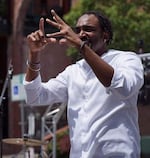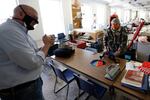Rian Gayle works at Western Oregon University, helping students with disabilities. He converts textbooks into audiobooks for blind students and makes sure there are wheelchair ramps to classrooms.
Gayle lost 75% of his hearing as a toddler to meningitis. He can still hear loud sounds, like a car rushing by. But he can’t hear softer sounds, like speech. So he answered OPB’s questions via an interpreter.

Rian Gayle interprets the music of a deaf hip-hop artist at the Make Music event in Salem in June 2019.
Courtesy Rian Gayle
“I am Rian Gayle, a Black deaf man who relies on sign language and is living in Salem, Oregon,” Gayle said.
He said masks have made communication even more challenging for him.
“Masks have changed things tenfold. One example out of many was when I was at Roth’s and was asking someone a question by typing on my phone and I then would let them speak into my phone to use the speech-to-text app. But the person refused to come close or even take off the mask a bit for me to see their lips.”
Gayle said the employee simply cited a company policy on masks.
“I asked if they could just write it down or maybe use their own phone? But nope! That’s audism — discrimination based on auditory abilities,” Gayle said. “I got upset and asked to speak with the manager. Many other Deaf people had the same issue or similar.”
In other situations, Gayle said, accommodations have been made. Like when his wife gave birth at a hospital during the pandemic, “Luckily we had an interpreter, but everyone was masked.”
That meant everyone was safe, but communication remained difficult.
Anais Keenon is in a similar situation. She’s a human resources program specialist in Portland and was born 30 years ago, the same year Congress passed the Americans with Disabilities Act prohibiting discrimination against people who are deaf, blind or otherwise impaired.
Related: Move to include: OPB celebrates 30 years of the ADA
Without hearing aids, she misses 85% of sounds and says masks cover up the visual information she needs.
“To go from being able to interact in person and being able to decipher what is being communicated through body language, through lip reading, through facial reading to all of a sudden not having access to that has been very very difficult,” Keenon said.
Keenon said the increase in virtual meetings hasn’t helped much, either. Imagine trying to lip-read for hours on a tiny screen and meetings are scheduled back-to-back as people no longer have to travel from one meeting spot to another.
“I am utterly exhausted by the end of that,” Keenon said.
She would prefer if people wore clear masks, so she could see mouths and expressions. But even clear masks have problems: they fog-up and sometimes cover the nose and chin, both of which are needed to lip read.

In this June 3, 2020, photo, Michael Conley, left, who is deaf, talks with San Diego Opera costume director Ingrid Helton, right, while wearing a mask with a window in San Diego. Face coverings to curb the spread of the coronavirus are making it hard for people who read lips to communicate. That has spurred a slew of startups making masks with plastic windows to show one's mouth. The companies are getting inundated with orders from family and friends of deaf people, people helping English learners see the pronunciation of words, and even hospitals that want their patients to be able to see smiles.
Gregory Bull / AP
“I can do tolerably well for a while, but it’s almost like my brain just sort of disconnects and says, ‘Nope, I’m out of here,’ if the conversation goes on too long,” Keenon said.
It may seem counterintuitive, but masks can create challenges for blind people too.
“It’s hard to explain but sounds get muffled,” said Lisa Ferris of Hillsboro, who is both deaf and blind, although she can see and hear a little.
“Your breathing sounds louder and it kind of gets in the way of your hearing, your echolocation, proprioception kind of thing. So it can be little more disorienting,” Ferris said.
She also prefers transparent face shields when communicating, said Ferris. “I cannot see faces, so I’m not quite sure why that is, but it still seems to work better for me.”
Ferris said blind people also have problems with social distancing and new procedures, like standing on tape markers in stores or seeing signs explaining new policies.
“There have been a few impatient people when I walk down the sidewalk with my guide dog, she has no clue about social distancing. Her entire training is based on keeping me on the sidewalk,” Ferris said. “And so I really depend on other people to move around me. I don’t mean to be rude but I can’t see you, or sometimes hear you when you’re coming.”
She said the solutions for many of the problems blind and deaf people face are the same as those required during normal times: accessibility everywhere, adherence to ADA laws, and inclusive procedures.
Tom Stenson, with Disability Rights Oregon, said he’s received feedback from people like Ferris, Keenon and Gayle. But he doesn’t think society is going to suddenly change to large, transparent masks.
But he has been reaching out to places like hospitals to make sure they have them on hand.
“You know that’s not a circumstance where you want to miscommunicate in any way,” Stenson said. “You want to be really clear on whether someone is allergic to the drugs they’re going to take or whether they understand how to take a medication.”
He’s also letting businesses know that staff who’ve gotten along by lip-reading and hearing aids in the past may now be asking for sign language interpreters or closed captioning.
“Employers and health care providers shouldn’t assume that people are being needy or unreasonable by asking for an accommodation that they didn’t ask for before. It’s because what they need is changing because people are wearing masks,” Stenson said.
Estimates vary, but about 15% of Americans say they have a hard time hearing. Fewer people say they have visual problems. But what that means is that three out of every 20 people you meet might like you to lower your mask a little while talking — so long as you’re standing at least 6 feet away.
This story is part of Move to Include, supported by the Corporation for Public Broadcasting.
